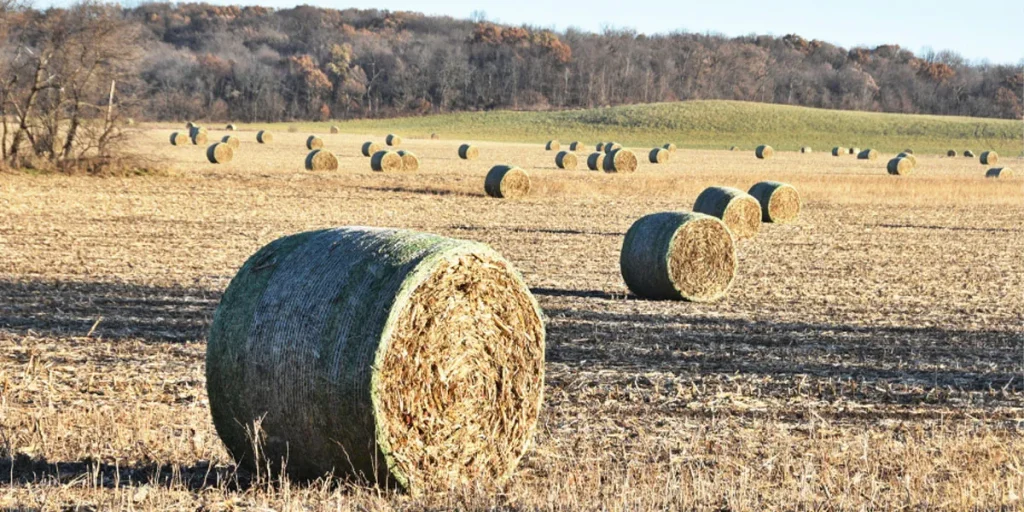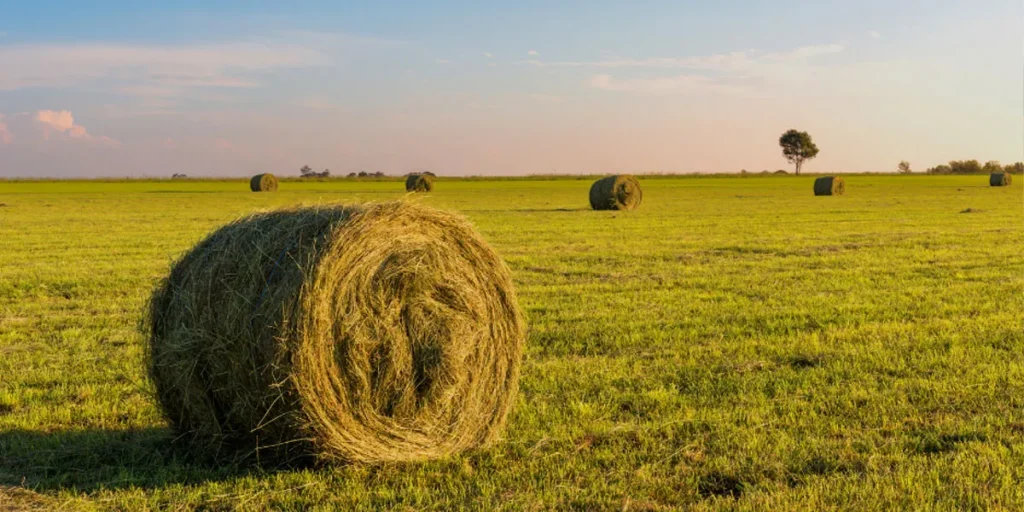A 5×5 round bale typically weighs between 800 to 1,200 pounds. The exact weight can vary based on the type of forage and its moisture content.
Exploring the specifics of round bales is vital for farmers and those involved in agriculture to manage their operations effectively.
The weight of a 5×5 round bale is contingent on various factors, including the material’s density and the conditions during baling.
This information assists in determining transport requirements and feed rations. Hay is the most common content of these bales, and its density can significantly influence the weight.
Knowing the weight of these bales is essential for proper storage and to minimize any potential wastage or spoilage.
Therefore, understanding bale weight helps in maximizing efficiency in agricultural practices and ensures the seamless flow of operations from field to barn.
Diving Into The World Of Round Bales
Enter the sphere of agriculture, where round bales reign. These hefty rolls are essential for farmers worldwide.
They store and feed livestock throughout the seasons. A common size is the 5X5 round bale. One question often asked: “How much does it weigh?” Let’s unravel this hay bale mystery.
Size Matters: Understanding 5×5 Bales
5X5 bales stand tall in fields and barns. This specific dimension refers to a bale 5 feet wide by 5 feet in diameter.
Their size affects how much they can hold and the weight. A typical 5X5 hay bale can weigh between 800 to 1,200 pounds (363 to 544 kg), but this can vary.
- Depends on hay type: Different crops yield different weights.
- Tightly wound: A tighter roll adds more heft.
- Moisture level: Dryer hay is lighter.
Key Factors In Weight
Two critical elements influence weight:
Material: What’s inside matters. Hay type and quality change the scale. Straw is lighter; alfalfa or clover is heavier.
Density: How compact the bale is. High-density bales have less air, more plant material. They weigh more. A table shows typical materials and their estimated weights in a 5X5 bale.
| Material | Estimated Weight |
|---|---|
| Hay | 900-1,200 lbs |
| Straw | 500-700 lbs |
| Mixed Grasses | 800-1,000 lbs |
Different factors play a role in the weight of 5X5 round bales. Material and density top the list. Understanding these can help in handling and storage.
It aids in calculating feed stock and transportation needs. All these tips ensure efficient farming operations and healthy livestock.
Calculation Of A Bale’s Weight

Understanding how much a 5×5 round bale weighs is crucial for farmers and transporters alike. Knowing the weight helps in planning the storage, transportation, and feeding of livestock.
The calculation of a bale’s weight involves some industry standards and the actual weighing process.
Standard Weights
Common knowledge in the farming industry gives us a range for 5×5 round bale weights. Let’s look at standard weights.
- Grass Hay: Generally weighs between 800 to 1100 pounds.
- Alfalfa Hay: Tends to be heavier, with bales commonly around 1000 to 1300 pounds.
- Mixed Hay: Falls in between, often weighing 900 to 1150 pounds.
These weights can vary based on moisture content, the density of baling, and the type of hay.
Weighing Methods
The exact weight of round bales can be determined using different methods suitable for various setups.
- On-Farm Scales: Farmers use these to weigh tractors and trailers before and after loading bales.
- Portable Bale Scales: Allow for direct bale weighing and are convenient for use in the field.
- Feed Store Scales: Provide weight tickets for transport documentation when selling hay.
- Laboratory Scales: Used in precise scientific measuring, often for research purposes.
Correct weighing ensures safe handling and accurate feed management.
Variables Impacting Bale’s Weight
Understanding the weight of a typical 5×5 round bale helps in logistics and feeding calculations.
Yet, several factors can alter its heft. These variables range from moisture content to the type of crop harvested.
Moisture Content
Moisture content is crucial in determining bale weight. Higher moisture means a heavier bale, but too much can lead to spoilage or combustion. Ideal bales possess a moisture level between 15% and 18%.
- Below 15%: lighter, at risk of being too dry
- 15%-18%: optimal weight and quality
- Above 20%: heavier, with a higher spoilage risk
Crop Types And Their Influence On Bale Heaviness
Different crops result in bales with varying weights. Here is a comparison between common crops:
| Crop Type | Average Weight per 5×5 Bale (lbs) |
|---|---|
| Alfalfa | 1,000-1,200 |
| Grass | 800-1,000 |
| Straw | 400-600 |
| Mixed Hay | 900-1,100 |
Alfalfa is dense, leading to heavier bales. Straw, however, is lighter, affecting overall bale weight considerably.
Comparing 5×5 Bales To Other Sizes

Understanding the weight of a 5X5 round bale helps in planning and logistics. It’s essential to compare these bales to various sizes available.
This comparison highlights the benefits and drawbacks of each size for different needs. Let’s weigh in on how a 5X5 bale stacks up against others.
From Small Squares To Large Rounds
Bales come in all shapes and sizes, each with a unique weight. Typically, small square bales are easy to handle, weighing between 40 to 60 pounds.
As we move up the size chart, large square bales tip the scales at around 750 to 850 pounds.
Massive round bales dominate the spectrum, and a standard 5X5 round bale weighs approximately 800 to 1600 pounds.
The weight varies due to moisture content and the type of forage.
- Small Square Bales: 40-60 lbs – Ideal for small farms
- Large Square Bales: 750-850 lbs – Suited for efficiency
- Small Round Bales: 400-600 lbs – Easy storage and transport
- 5X5 Round Bales: 800-1600 lbs – Balancing convenience and volume
Efficiency And Usage: Balancing Size And Weight
Choosing the right bale size brings a balance between efficiency and usage. Small square bales are perfect for individual feeding and minimize waste.
Large round bales, such as 5X5, optimize storage and reduce handling time on the field. Understanding these benefits helps you make a smart choice for your specific farming needs.
| Bale Type | Efficiency | Usage |
|---|---|---|
| Small Square | High | Individual Feeding |
| Large Square | Medium | Commercial Farms |
| Small Round | Medium | Small to Medium Farms |
| 5X5 Round | Low | Bulk Feeding & Storage |
Selecting the correct bale size can significantly affect your operation’s effectiveness. It plays a role in the time, resources, and machinery required.
The weight of a 5X5 round bale stands in the middle, offering a practical choice for many farmers.
Practical Implications For Farmers And Buyers
Farmers and buyers often deal with large round bales in their daily operations. Knowing the weight of a 5×5 round bale is essential.
This information affects both transportation and cost. Let’s dive into the practical aspects of handling and pricing these bales.
Transportation Logistics: Moving Heavy Bales
Efficiently transporting 5×5 round bales is crucial for farmers and haulers. These bales can weigh between 800 to 1,200 pounds, depending on the material and density.
Such heavy loads require appropriate equipment and strategies.
- Flatbed trailers or specialized trucks are necessary.
- Load distribution must be balanced for safe travel.
- Drivers should possess knowledge of weight limit regulations.
Without the right knowledge and tools, moving these bales can be a challenge. Always plan routes and schedules with the bale weight in mind.
Cost Calculations: Pricing Based On Weight
Buyers focus on the cost-effectiveness of their purchases. They must understand how weight impacts price. Sellers often price hay by the ton.
Thus, knowing the weight of a single bale is imperative for correct cost calculations.
| Bale Type | Weight Range (lbs) | Price per Ton |
|---|---|---|
| 5×5 Round Bale | 800 – 1,200 | $Price |
Use this table as a guide to determine the cost of a load.
- Calculate the total weight of your bales.
- Determine the price per ton for the current market.
- Estimate a fair price for the total haul.
With a clear understanding of weights and costs, farmers and buyers can ensure fair and profitable transactions.
FAQ About the Weight of a 5×5 Round Bale
What Is The Weight Of A 5×5 Round Bale?
A 5×5 round bale typically weighs between 800 to 1200 pounds. This range accounts for the variation in moisture content and the type of hay.
How Do Factors Like Density Affect Bale Weight?
The density of a round bale impacts weight significantly. Higher density bales will weigh more, as they contain less air and more compressed forage material.
Can Hay Type Influence A 5×5 Bale’s Weight?
Yes, the type of hay can influence the weight of a 5×5 bale. For example, alfalfa bales are usually denser and thus heavier than grass hay bales.
What’s The Average 5×5 Round Bale Weight For Alfalfa?
The average weight for a 5×5 round alfalfa bale is around 1000 to 1200 pounds. Alfalfa’s denser nature contributes to a heavier bale.
Conclusion
Understanding the weight of a 5×5 round bale is crucial for proper handling and logistics. On average, these bales tip the scales at 1,000 to 1,200 pounds.
This knowledge facilitates informed decisions for transport and storage. Remember, exact weights can vary, so always verify specifics for your needs.
Stay informed for efficient farming operations.
Resources:
https://www.canr.msu.edu/news/large_round_bale_storage
https://extension.okstate.edu/fact-sheets/print-publications/bae/round-bale-hay-storage-bae-1716.pdf
